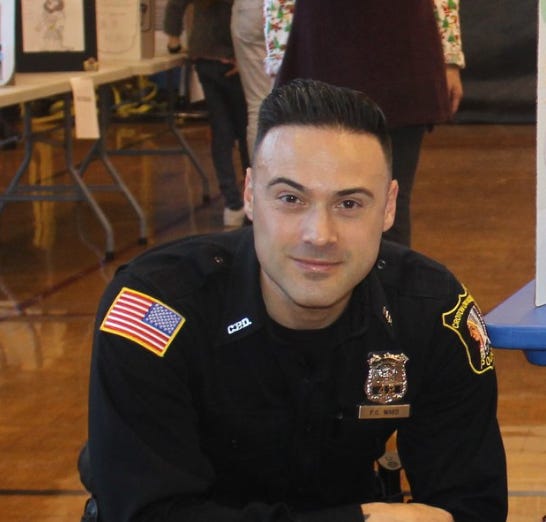Village justice explains turnaround on armed officers in Croton-Harmon schools. District says it is not considering SROs at this time, but might do so in the future.
Sam Watkins startled many Crotonites with back-to-back letters in The Gazette calling for SROs in our schools, then rescinding that position. Studies show limited evidence that SROs stop violence.
The year 2022, the last year for which we have full data, was the worst ever for school shootings in the United States. There were 302 recorded shootings, nearly one each day on average, according to the K-12 School Shooting Database.
Thus one can understand the concern that Croton Village Justice Sam Watkins expressed in a letter in the December 7-13 issue of The Gazette, calling for the Croton-Harmon school district to hire School Resource Officers (SROs) for our schools—the functional equivalent of having a trained armed guard to protect students.
But many Crotonites were startled to see another, briefer letter from Watkins in The Gazette the following week, in which he took back his call for SROs to be put in place. Rumors began to fly: Had school district officials pressured Watkins into changing his stance? The answer turns out to be no, Watkins said, but is no less interesting.
The back-to-back letters reflect an ongoing debate about how best to protect students from mass shooters and other violence, including whether SROs are truly effective in doing that.
Watkins spoke to the Chronicle about the motivations behind each of his letters. But first, for those who either did not see them or want to be reminded about what they said, here they are (with apologies for the handwritten notations by your humble correspondent):
In our conversation, Watkins stressed that he was writing as a private Croton citizen and not in his official capacity as Village Justice; the editor of The Gazette, he said, added the identifications.
Watkins said that there were two main motivations for his first letter. First, he has five grandchildren currently in school. “My concern is that they be protected,” he said, “and that all students be protected.”
Second, Watkins had spoken with Croton police officer Kevin Ward, who runs the DARE program in Croton-Harmon’s middle school and is an advocate of SROs. The DARE program is designed to increase communication between students and law enforcement, and covers topics ranging from substance abuse to proper listening and peer pressure to bullying.
About a year ago, Watkins told the Chronicle, he was able to walk into our high school “without being stopped.” That made him fear that “anyone could walk into the schools with an AK-47.” And more recently, Watkins said, he had a conversation with a school board member who suggested that the expense of hiring three SROs—one for each school—was an important reason it had not yet been done. This inspired Watkins’s pointed question about whether money should stand in the way of school safety. “What is a child’s life worth?” he asked.
So what made Watkins change his mind?
Watkins said that he was not invited by the school district to tour the schools and inspect their security measures. Rather, he simply went to each school on his own and tried to enter. “I could not get in,” he said. “At each school you have to speak into a microphone” and be visually identified by school personnel. Watkins added that security at the schools seemed to have improved since he was able to get into the high school without being stopped a year ago.
“I had no hesitation in writing that second letter,” Watkins told the Chronicle, especially after finding that the current security arrangements left him “standing outside in the cold.” (Watkins later had a chat with Croton-Harmon schools superintendent Stephen Walker which he also found reassuring.)
Watkins concedes that the current security system is not foolproof against a shooter armed with a high-powered weapon, such as an assault weapon. Thus the shooter in the Sandy Hook massacre shot through a glass door to get inside, and the more recent experience in Uvalde demonstrates that even a large armed continent of law enforcement officers can sometimes fail to protect students. On the other hand, Watkins said, having an armed SRO in the school would also “not protect against all comers.”
Scientific studies provide little evidence for the effectiveness of SROs preventing violence in schools—but some disagree.
One of the most active research groups studying violence in schools is The Violence Project, housed at Hamline University in St. Paul, Minnesota. Its primary leader, Jillian Peterson, an associate professor of criminology and criminal justice at Hamline, has made many media appearances to discuss the group’s findings, which have also been published in the peer reviewed social science literature. (A particularly clear and accessible interview with Peterson can be found at this link.)
In one key study, published in 2021 in the journal JAMA Network, Peterson and her colleagues found that having armed guards in the schools actually increased the rate of deaths by nearly three times. Other studies have come up with similar results, including findings that having SROs in the schools does not decrease the number of infractions by students.
These findings may seem counterintuitive, but Peterson and other researchers have hypothesized about why they might be correct. One factor could be the long-studied “weapons effect,” in which the mere presence of weapons in a school—even in the hands of law enforcement officers—might increase aggression in some students. And in the case of mass school shootings, which rise far above more minor conflicts in the school setting, many of the perpetrators have shown suicidal ideation shortly before they committed their acts. Moreover, a very large percentage of school shooters are either current or former students, making it easier for them to gain entrance into schools.
But not everyone involved in school safety and security agrees with this negative view of the effectiveness of SROs. As might be imagined, the National Association of School Resource Officers does not, and the group has put out a variety of documents on its Web site to counter such arguments (see, for example, “Reality Over Rhetoric when it comes to School Resource Officers.”)
Likewise, Croton police officer Kevin Ward, who works closely with the schools and whom Sam Watkins credits with alerting him to the safety issues, thinks having SROs present can help save vital minutes during an emergency.
“If there’s an officer stationed in the school and something breaks out, in less than a minute they can get from one end of the school to another,” Ward told the Chronicle. Ward added that having SROs in the schools acts as a deterrent. “Knowing there’s a police officer in the school” can make a presumptive shooter think twice, he said.
Ward also disagrees that SROs, who normally would carry sidearms, would automatically be outgunned if a shooter came in with an AR-15 or other assault weapon. “It’s a matter of training,” he said, adding that SROs can keep rifles in a closet and call in reinforcements whenever necessary.
Ward said that the Croton police department currently has three trained SROs in its ranks, even though the school district has not yet made a budget line available for hiring them to guard the schools full-time. He added that this issue is scheduled for discussion at the next Croton Police Advisory Committee meeting in January.
In a written statement provided to the Chronicle, schools superintendent Stephen Walker laid out the district’s current thinking on the question of SROs and budgetary priorities, which we quote in full:
“The district has a terrific relationship with Croton PD and that they provide our schools and events with regular support and visibility and have collaborated on emergency planning. Further, the proximity of our schools to Croton PD makes for an incredibly quick response time should there be an emergency.
The district has also invested considerably in security measures. All schools are well-equipped with cameras, visitor management systems, and other safety technologies. Staff members are well-trained and regularly participate in safety drills including our security consultants and Croton PD officers.
Several of our security guards are former law enforcement officers.
While the district is not considering employing an SRO(s) at this time, it is not saying that it would not consider this position in the future. The financial investment involved in an SRO for each of our schools has not yet risen to the top of our list of budgetary priorities, which currently includes new faculty members and school counselors.”
There is no doubt that protecting the safety of our students is very much in the minds of educators, law enforcement, and ordinary citizens. The only question is how best to go about doing it. Look for much more discussion of that issue in the coming year.
Comments policy: No personal attacks, please be polite and respectful to everyone.







I love what you’re doing here they should be named and shamed they have a duty to report to the residents who are the real owners of Croton. With all the crap Chief Miller H.L. and his donut crew put us through I wouldn’t be surprised if there were several other deals being negotiated without the taxpayers of the village having a clue. They are not very eager to talk about 1 half moon bay???? That’s the definition of corruption! I wish residents of the Village a Happy Healthy Holiday and a Happy and safe New Year! Don’t tolerate politicians jerking you around it’s not right!!! Stand up for your village or before you know it the only grass that can be cut with a gas mower will be Dobbs Field! I thought of a solution claim eminent domain on one Half Moon Bay add it to the park done!
All due respect to Sam Watkins, I think he was right the first time. A locked front door is no deterrent to a psychopath bent on murder. I agree with Officer Ward that an SRO would definitely be a deterrent. And I agree with Sam’s original statement that there can be no budget concerns that can allow our kids to be less safe in an age where we are all wondering if we are next.
Here’s an idea: a 500% federal tax on arms sales to be used directly for providing school protection in all schools nationwide.
We tax cigarettes heavily to reduce the damage that they do. Why not firearms?